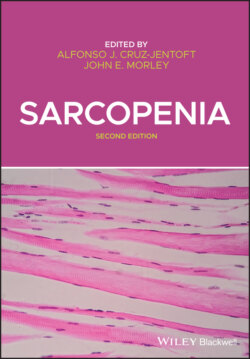Читать книгу Sarcopenia - Группа авторов - Страница 21
THE FRONTIERS: FRAILTY, CACHEXIA, MALNUTRITION
ОглавлениеFrailty, cachexia, and malnutrition are conditions that share some elements with sarcopenia: they are frequent in old age, predict adverse outcomes, and include in some way low muscle mass within their definitions, which may lead clinicians into problems when trying to sort out which condition predominates in a given patient [38, 39].
The Global Leadership Initiative on Malnutrition (GLIM) has proposed a definition of malnutrition that includes reduced muscle mass as one of the three phenotypic diagnostic criteria [40]. Thus, the finding of a low muscle mass with normal muscle function may suggest that malnutrition is present, although this may well be the start toward a malnutrition‐related sarcopenia.
Low muscle mass is also included in the most widely used definitions of cachexia, which also consider the role of low muscle strength [12, 41]. The border between disease‐related sarcopenia and cachexia (a time‐honored term used to describe severe weight loss and muscle wasting associated with severe inflammatory conditions) is quite blurred, usually depending on the degree of inflammation, the underlying pathophysiology, the triggering condition, and even the discipline the practitioner comes from [42].
The links between physical frailty and sarcopenia are addressed in a different chapter. However, it is relevant that the frailty phenotype includes unintentional weight loss (usually associated with muscle wasting), weakness (defined by a low grip strength), and reduced physical performance (slow walking speed) [43], all of them part of the definition of sarcopenia. Both conditions are closely linked, sarcopenia being a player in a relevant portion of cases with physical frailty [44, 45]. International and Asian definitions of physical frailty exist [46, 47].
